Flower Glossary is reader-supported. When you buy through links on our site, we may earn an affiliate commission.
If you are a fan of water lilies, you’ve probably heard of the artist Monet. Even if you are not particularly familiar with the flower, you may have heard of his painting series called ‘The Water Lilies’, or ‘Nymphéas’.
If someone could vouch for the beauty and versatility of the watery lily family, it was Monet.
His paintings depict thousands of water-topping flowers; their elegance, tranquility, their range of colors, and their beauty.
Alongside the French painter, hundreds of cultures and people around the world have been celebrating water lilies for centuries.
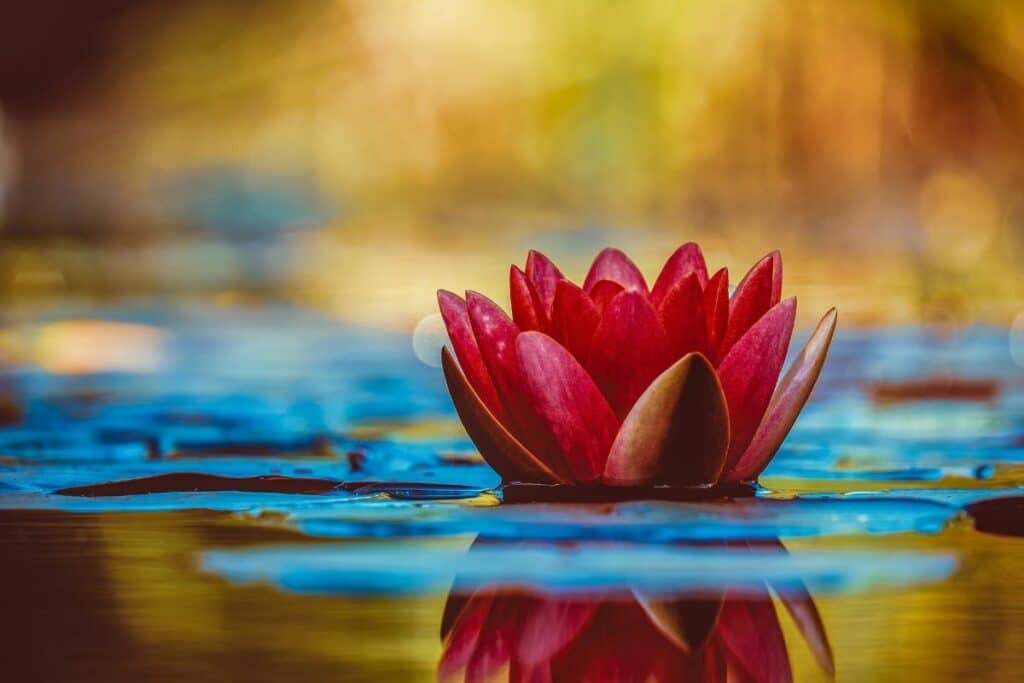
Part of the reason behind their popularity is that water lilies are notoriously easy to grow, and can be found almost anywhere in the world.
Also, they have been around for hundreds of millions of years, so they are pretty impressive flowers.
Because these flowers are so impressively stunning, it is not surprising that people want to know more about them.
If you are thinking about growing your own water lilies in your garden pond, or if you just want to learn a little more about them, keep on reading!
We will discuss the different varieties of lily that are available, their colors, and show you what they look like.
Table of Contents
Water Lily Families
Water lilies exist in three different family groups, and these are the Nymphaeaceae, the Hydatellaceae, and the Cambobacae families.
Wow, they’re a bit of a mouthful, aren’t they? Within each of these three families are a set of subspecies, all of which are unique in color, shape, and size.
In total, there are over fifty species of water lily in the world. Most species of water lilies fall into the Nymphaeaceae family.
The official names of the subspecies in this family are Barclaya, Nuphar, Ondinea, Victoria, Euryale, and Nymphaea.
However, there are so many subspecies within these groups that we will focus more on each flower’s individual name.
Water Lily Colors
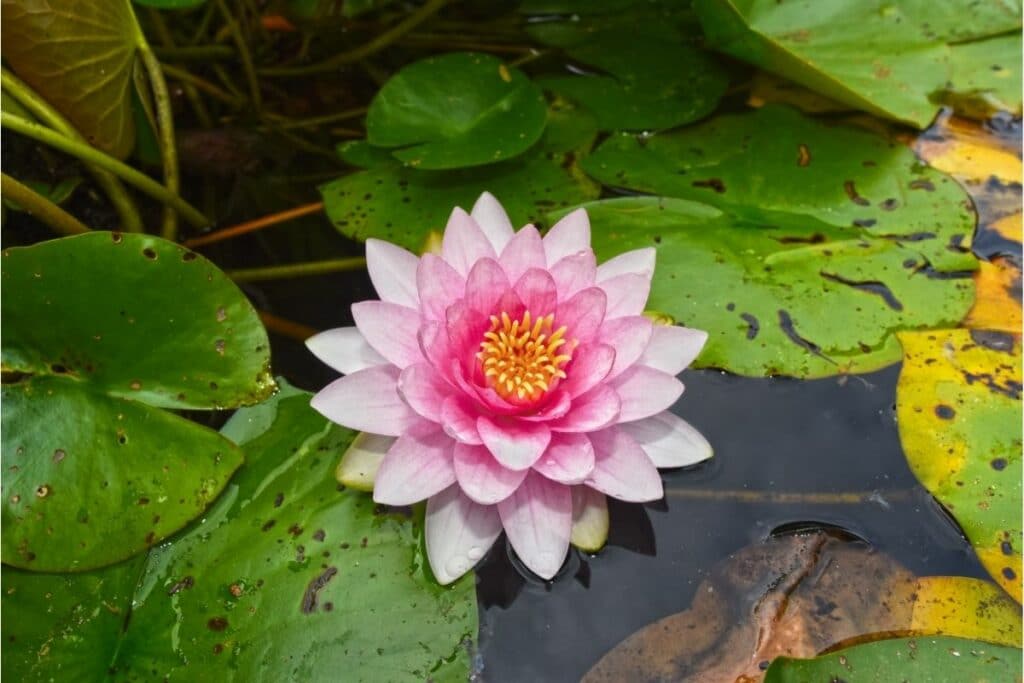
When you think of water lilies, you probably picture some light pink flowers atop light green lily pads, right? And you would not be wrong!
So many water lilies are light pink in color. However, what many people do not know is that water lilies exist in a whole range of colors and shades – there is at least one lily for every color of the rainbow!
As well as pink lilies, you can find yellow, orange, blue, purple, red, white, and even black lilies.
Even the colors of lily pads vary; and they can range from very light green to deep, dark green, and some are even red or purple! Just like all flowers, water lilies come in a range of shapes, sizes, and colors, and each flower is unique.
Nymphaeaceae Water Lilies
Because this family of water lilies has the most subspecies, we are going to focus on the Nymphaeaceae family’s subspecies in this article. Let’s take a closer look at some of them below.
Nymphaea Darwin
More commonly referred to as the Pink Water Lily, this is one of the most common species of water lilies.
As you might have guessed, the petals of this flower are shades of pink. Its inner petals tend to be a light, sweet pink, while its outer petals are a darker bright pink.
Inside these petals are bright yellow stamens, which create a beautiful contrast with the pink.
The flowers are fairly large and can reach up to seven inches tall.
They are also extremely fragrant, and delightful to smell. These pretty flowers sit atop rounded bright green lily pads that support them on the water surface.
Unfortunately, these beautiful flowers never last long and are usually only open for around four days at a time.
Rembrandt Water Lily
Artists and water lilies seem to go hand in hand! This lily was named after the artist, Rembrandt, supposedly because it mimics his painting style. If you are a fan of vivid pinks, you will love this water lily.
Its petals range in color from deep, dark pinks to bright shades of fuchsia, and they are eye-catching, to say the least.
These flowers love the sun, so only bloom during the daytime.
These are no simple little flowers, though, these babies can grow up to five feet in diameter! When they are full-sized, they really are hard to miss.
Despite their scale and bright color, these water lilies are still as elegant as any other.
Nymphaea Capensis
More simply named the Cape Blue Water Lily, this is the perfect flower for those who are not a huge fan of pink.
This flower has petals that range in color from deep purple to light indigo, and a yellow and purple center. Unlike many of the water lily species, this flower does not have rounded, delicate petals, but instead has thin and pointed ones.
They still look fragile and elegant, but not quite as tranquil as some others’.
One great thing about this water lily species is that it can survive over long periods of time without water; it is incredibly resilient in hotter climates.
Another benefit of this flower is that it blooms repeatedly throughout the year; you won’t have to worry about only having a small timeframe to enjoy their beauty in, like the pink water lily.
These lilies are even larger than the Rembrandt lilies, and can reach up to eight feet in diameter! They sit upon dark green lily pads that have jagged edges.
Midnight Water Lily
Despite what its name suggests, this water lily actually blooms throughout the day. It is similar in appearance to the Nymphaea Capensis.
It has long, spiky, purple petals that range in tone from deep purple to light violet, and each flower has a yellow center.
They grow above bright green lily pads that are rounded but with slightly jagged edges, and each flower can reach up to 5 feet wide.
These flowers need full sun to thrive, and when they do thrive, they give off a beautiful subtle fragrance.
Alba Water Lily
This beautiful water lily has pure white petals that grow in around three layers, all of which are fairly long with rounded points.
In the center of these white, delicate petals is a mass of bright yellow stamens, which complement the light petals perfectly. It sort of looks like a fried egg in flower form, but much more beautiful!
This flower grows atop dark green, round lily pads – the kind of lily pads you picture when you think of typical lily pads!
This delicate little flower can reach up to 12 inches in diameter, and thrives most in warm climates – it loves the sun. It really is a sunny-side-up kind of flower!
Mrs. George H. Pring Water Lily
If white lilies are what you are after, you will love these subspecies.
Like the previous water lily, this one loves the sunlight and fares best in hot climates. Its petals are rounded and long and have tones of white, cream, and even light yellow in places.
These light flowers are much larger than the Alba water lily, and can grow up to 6 feet wide! Their best feature, in our opinion, is the strong fragrance that they emit when in bloom.
Marliacea Carnea Water Lily
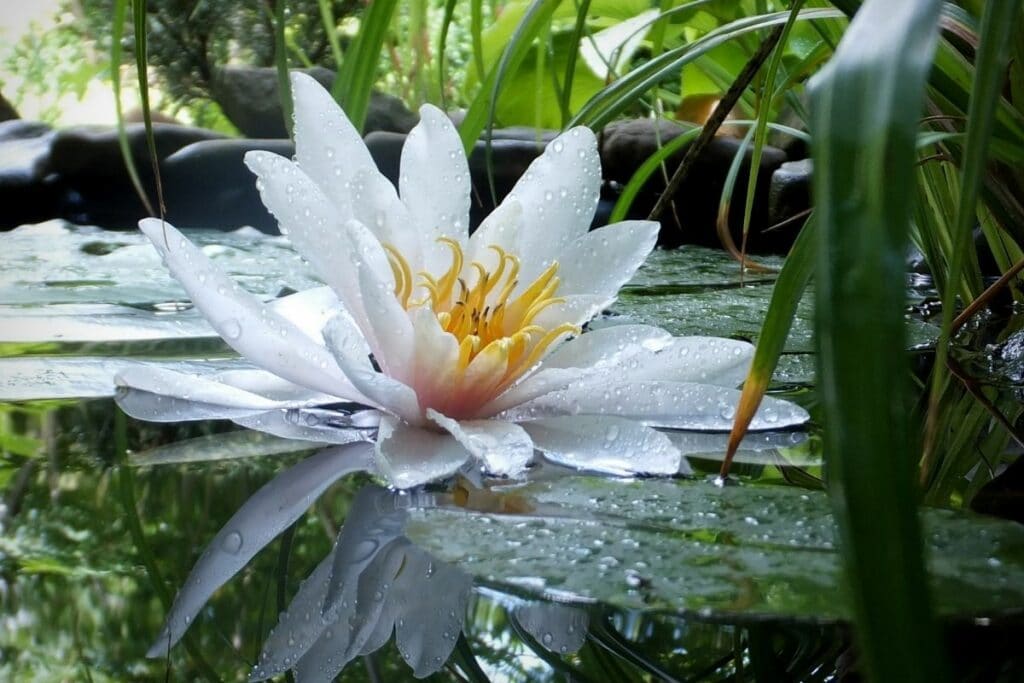
Next up is a lily that grows wide – up to five feet wide – and which matches its size with its beauty.
This is one of our favorite water lily subspecies – we just don’t think there are many flowers that are able to match its beauty.
The petals on this species are delicate, elegant, and softly rounded at the edges.
They grow in three layers and give the flower a cup-like shape.
The color of this flower is what makes it so elegant; each petal is a soft, whitish shade of light pink, which deepens slightly as it reaches the base of the flower.
The subtlety in color is just beautiful and is timeless.
Contrasting with the light pink shades is the bright yellow placed at the center of the flower. Its bright stamens complement the subtle petals and emphasize their beauty.
With their beauty comes to some vulnerability; these flowers are not quite as resilient as some other water lily subspecies, and they do not fare well in hard climates.
Afterglow Water Lily
The name of this water lily stems from the fact that it really does look like it glows! This lily is one of the most beautiful subspecies of the Nymphaeaceae family.
Soft, rounded petals grow outwards and upwards to reveal shades of pink, purple, yellow, and orange.
The petals have their deepest pink color at their tips, and the color gradually transforms into yellow as it reaches the center – this is what gives the flowers their supposed glow.
These flowers are as bold as they are beautiful, and they can grow to a whopping eight feet in diameter, and they release a strong fragrance when they are in bloom.
We love these flowers, and just wish we had our own pond big enough to house them!
Colorado Water Lily
This next water lily is gaudy – in a lovely way. Its petals are flamingo pink in color and are accentuated by a bright orange center of stamens.
The petals are thick and pointed, and their lily pads are so colorful that they can sometimes appear red instead of green.
Colorado water lilies can reach a width of five feet. Despite their bold and tropical colors, though, these flowers fare surprisingly badly in hot climates and prefer mild conditions.
Carolina Sunset Water Lily
If you like sunny-yellow flowers, the Carolina Sunset lily might just become your favorite!
It has light yellow, peach-colored petals that open during the day when they get their hit of sunlight.
When open, these petals reveal an even brighter center; its stamens are a vibrant shade of deep yellow.
These flowers are bold, but small, and have a maximum diameter of around eight inches.
As well as looking beautiful, these flowers also smell wonderful, thanks to the strong fragrance they produce when in bloom. These sunshine flowers grow above light green lily pads.
Chromatella Water Lily
Another yellow-tastic water lily is the Chromatella water lily. It has pale yellow petals that grow to long rounded points, and which grow in a few different layers.
Like the Carolina Sunset water lily, these lilies get more and more yellow the closer you get to their center.
These lilies grow among lily pads that are wrinkled and dark green, which really accentuate their light yellow tones. This lily is one of the smallest subspecies, as it is a dwarf variety of water lilies. This means that it is very delicate.
As opposed to many lilies that thrive in full sunlight, this water lily does best when everything is in moderation; it likes partial shade and partial sun. We think they should call this plant the Goldilocks water lily!
Emily Grant Hutchings Water Lily
Why do so many people get to have a water lily named after them? We want a pretty flower to be named after us, too!
Anyway, Emily Grant Hutchings, whoever she is, is very lucky, because this flower is absolutely stunning.
The petals on this water lily are vibrant and bright, and are usually dark pink in color, but can also be a bit purple.
Interestingly, though, this water lily is a night bloomer, which means that its gorgeous petals only open up and display their beauty at night.
However, this flower species is pretty easy to propagate and is not too fussy about the sun or shade. We would love to see this flower in action, but we might need to buy some night vision goggles first…
Antares Water Lily
This is another night blooming water lily that only spreads its wings outside of daylight hours.
Its petals are often a very pretty pale pink, but they are also commonly seen with darker tones of fuchsia and purple-reds.
These flowers sit on top of rounded, crinkled, bright green lily pads.
One of the coolest things about these water lilies is that they are not just pink and pretty, but they are also incredibly useful.
Antares water lilies are actually able to purify the water they are in, much more so than most other types of lily.
Nymphaea Hermine
The Hermine water lily is comprised of light, white petals, which grow in layers around a bright yellow center.
The petals almost make a star shape as they grow, and the stamens in the middle look a little like anemones.
These delicate light flowers can actually grow up to three feet each in diameter, and they thrive the most when in full sunlight.
Helvola Water Lily
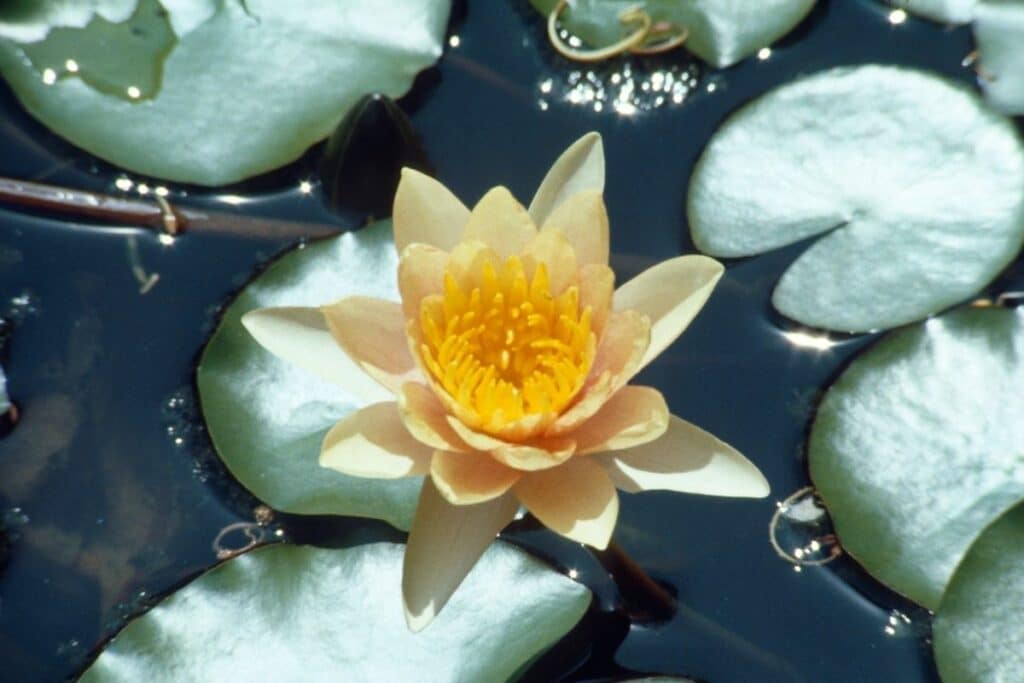
The Helvola water lily is absolutely gorgeous. It is subtle, sweet, and dainty. Petals on a Helvola water lily can either be white in color or can exist in a range of shades of yellow.
However, vibrant its petals are, every Helvola lily flower will have a bright yellow center of stamens.
The shape of this flower’s petals is slightly different from most other kinds of water lilies; they have the same slender shape and rounded point, but they tend to sometimes fold inwards at the edges.
These water lilies bloom during the day, they love sunlight, and they can grow up to three feet wide. Interestingly enough, its leaves can sometimes be purple!
George L. Thomas Water Lily
The George L. Thomas water lily is one of the most vibrant water lilies you can get. Its petals are plentiful and are covered in a bright pink color that reminds us of deep pink roses.
In the center of this pink mass are orange stamens, whose color really makes the pink of the petals pop.
This bright flower loves bright light, and blooms during the day.
As well as being one of the most colorful water lilies, the George L. Thomas water lily is also one of the largest; it can reach a diameter of up to twelve feet! These are more for lakes than little garden ponds!
Luciana Water Lily
This is the type of flower we picture when we think of water lilies. It has light pink, rounded petals which grow in tight rows, and which deepen in color as you get towards its center.
In the middle of these dainty petals is a cluster of bright yellow stamens.
These flowers grow among waxy, round, dark green lily pads. Luciana water lilies bloom during the day, but they do not like being exposed fully to the sun, so do require some shade.
Pygmaea Helvola Water Lily
This is a dwarf subspecies of water lily, and can only grow up to two inches wide.
It may be small, but this cute little flower is still a treat to look at, especially when it blooms during the day.
Its petals range in color from white to light yellow, to deep yellow, to light orange. In the center of these petals is a hub of bright yellow stamens.
The bright colors of these water lilies make them very attractive to bees, as well as to the human eye! The lily pads that they grow between are usually quite a dark green; this deep color really highlights their yellow petals and makes them stand out even more.
Pygmaea Rubra Water Lily
Pygmaea Rubra water lilies are a lot like Pygmaea Helvola lilies, except they are pink instead of yellow or white.
It is also a dwarf variety of water lily, but what it lacks in size it makes up for with its vivid pink petals and bright orange stamens.
The petals are long and pointed, and their pink color is so vibrant that sometimes the petals turn red in color, after a period of time.
The mid-green lily pads that grow around the flowers contrast beautifully with the petal colors, both when they are pink and when they are red.
We think red lilies are absolutely stunning, and they are so rare that they are a joy to admire.
Nymphaea Capensis
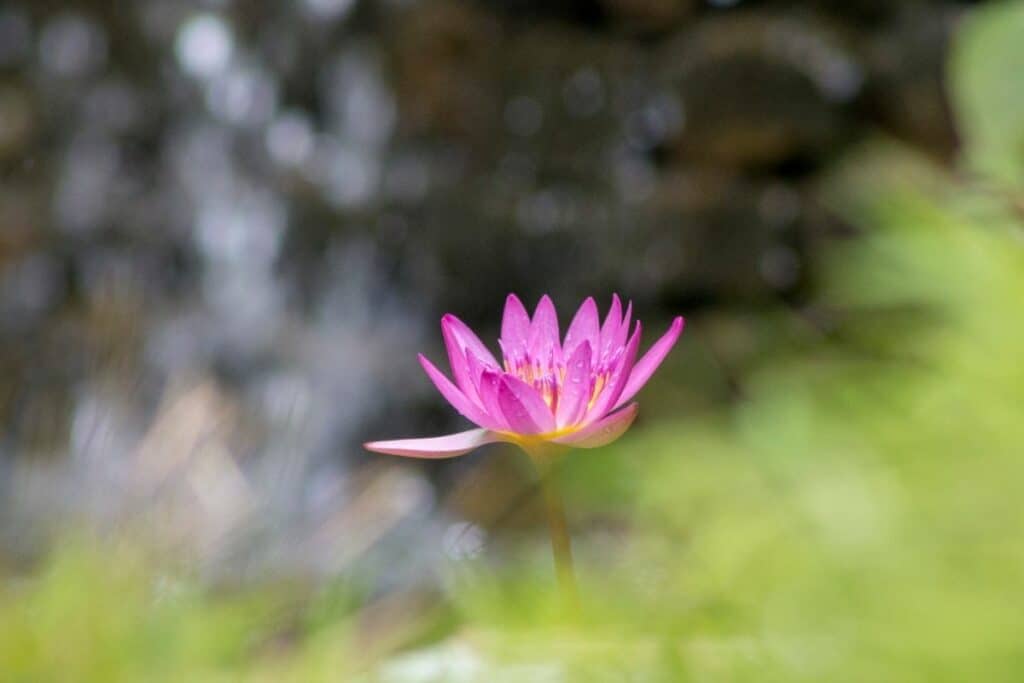
These water lilies are lovely to look at. Their petals are a little thinner than most other water lilies’, but the shape suits the flower.
The petals are usually white or very light pink, and they spread out to reveal bright yellow stamens.
As well as their two common colors, this flower can also occasionally be red or cream in color!
They love the sunlight, so Arc en Ciel water lilies bloom during daylight hours. They are medium-sized lilies and can reach a diameter of up to four feet wide.
Final Thoughts
Water Lilies have captured the hearts of people and cultures all over the world, and we are not surprised!
These ancient flowers have survived the toughest conditions that the world has to offer, and have done so with poise and beauty.
They can exist in climates all over the planet, and come in such a range of colors, sizes, and shapes.
They are as versatile as they are beautiful, and looking at them makes us want to elope to a chateau in France where we can grow our very own water lilies in our very own pond!